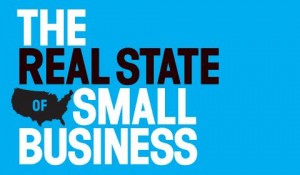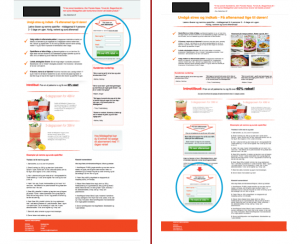Although more than three-quarters of B2B technology marketers use social media to market their products, less than half say they can tie social channels to revenue generation for their businesses.
This may be a problem with measurement, or with setting the wrong objectives for social media marketing (it’s far more effective for customer service and driving traffic to top-of-the-funnel content than to direct purchase, for example).

Image credit: BundlePost
But it may also be a problem with basic B2B social media marketing strategy. If you’re not sure your strategy is on track—or not sure what your company’s social media marketing strategy is—hopefully this post can help.
Cross-Platform Social Media Strategy
Regardless of the platform or network, B2B social media marketing is most effective for accomplishing three objectives:
Building relationships: Particularly on networks like Twitter, Pinterest and Instagram, people will follow your company long before they will give up their email address or pick up the phone to call you. It’s a low-commitment, low-risk way to check you out. But it’s a start—and, properly nurtured, can lead to a more valuable relationship (for both parties).
Engaging: Being “social” is about conversations. Start conversations with your followers by sharing great content; mentioning specific individuals in your social media posts (using “@” before their name on Twitter, LinkedIn, or Facebook, and “+” on Google+); and asking questions.
But at the very least, make sure you respond to anyone with comments or questions directed at you and/or your brand (except trolls). The biggest mistake (yet one that remains too common) any individual or brand can make on social media is ignoring direct contact from followers. Use social media monitoring tools to make sure you don’t miss opportunities to engage.
Driving traffic: Social networks, particularly the “big three,” can drive significant amounts of website traffic. Twitter is best for sharing news-oriented content and links; LinkedIn for industry research and business insights; and Facebook for more informal, humorous or fun content.
Blog posts are generally suitable for sharing across these networks plus others like Scoop.It, StumbleUpon, Tumblr, and Pinterest.
Platform-Specific Social Strategy
Each platform has its own strengths and personality. While it’s often fine to share the same content on different networks, how you share the content should be customized for each platform. For example, there’s no need to be bound by Twitter’s 140-character limit on other networks.
It’s also important to use hashtags correctly. Hashtags are very important on Twitter but can’t contain spaces. They are also essential on Tumblr but there they can contain spaces. And they shouldn’t be used at all on LinkedIn.
Here are a few more guidelines for specific social networks:
Facebook: The world’s largest social network is also one of the most personal, where people share news about friends, family, and relationships. Brands can play there, but it’s generally not a suitable venue for direct marketing or in-depth business discussions.
For companies and brands, Facebook works best for sharing casual workplace and event photos, videos, entertaining or humorous content, or content showcasing company culture and the lighter side of business.
LinkedIn: As Facebook is known as the place to find friends and family in social media, LinkedIn is commonly thought of as the place to find a job—or job candidates, if you’re hiring. Or as the place to network with people who can help you find that ideal job or candidate. This is why 94% of recruiters use LinkedIn to vet candidates.
But LinkedIn is also the preferred network for CEOs, and 74% of B2B decision makers say they use LinkedIn to help make purchasing decisions. Professionals use LinkedIn to find business insights, how-to content for problem solving, industry research and statistics, and thought leadership content.
Businesses and brands can use LinkedIn to share that type of content on their company pages. Employees and others associated with the firm can use it to share and amplify that content through their individual updates, in relevant LinkedIn groups, and by publishing articles on LinkedIn Pulse.
Twitter: For most businesses, this is one of the two most effective social networks (along with LinkedIn) for driving website and blog traffic. It’s ideal for sharing pithy observations, news, event-related information, and links to content that’s interesting and relevant to your followers.
Hosting or participating in Twitter chats is another effective way for marketers and other subject matter experts to expand their industry following and influence on Twitter.
Quora: Along with LinkedIn groups and industry-specific online forums, this is one of the best places to find and answer questions related to your industry and expertise.
Pinterest, Tumblr, Instagram: All are visually-oriented networks, primarily of value (so far) to B2C and consumer product marketers.
Again, across all social networks, engaging with followers is vital for success.
Social Presence Promotion Strategy
While there are a variety of active tactics for building brand presence on each social network (for example, using Twitter directories like WeFollow and Twellow), companies should at a minimum take advantage of all the passive follower-building opportunities available.
Include links to your brand Twitter, LinkedIn, Facebook and other social network accounts prominently on all pages of your website, and make these buttons even more blatant on your Contact Us page. Also add these links to employee email signatures, in marketing emails and newsletters, and on digital product collateral.
Social Audience Strategy
Your brand’s social media following includes several distinct groups of people, each with their own interests and priorities. For most companies, these groups include at a minimum:
- Journalists (trade, business, and local media);
- Industry bloggers and other influencers;
- Current customers;
- Prospective customers;
- Your team (employees, consultants, channel and business partners); and
- Prospective employees.
Depending upon your business structure and industry, followers may also include investors, industry analysts, suppliers, even regulators.
It’s essential to have a strategy for each group you’d like to engage with. Different social networks have different means of accomplishing this: LinkedIn and Facebook have groups for particular interests, Twitter allows you to create lists of specific followers, and Google+ uses circles.
Social Sharing Strategy
For business, social media sharing and interaction is ideally a mix of planning and spontaneity. Marketers should set up editorial calendars for social sharing just as for blogging, but these shouldn’t be so constraining as to inhibit spur-of-the-moment commenting or sharing based on brand interactions, world or industry events, or interesting content that pops up in monitored feeds.
As a starting point, social media marketers may want to follow a formula such as the 6-3-1 rule for social content sharing. For every 10 content items you share on social networks (particularly Twitter), include:
Six links to third-party content: The primary criteria for these links is that they be relevant and valuable to your audience (industry insights and statistics, thought leadership, lists and how-to posts, etc.). It’s fine to throw in something just humorous or entertaining now and then.
Be strategic with these links though; try to share links that help you build relationships as well as provide value. A link from a Forbes article or Mashable post may be relevant and informative, but 1) those sources aren’t going to acknowledge your sharing, and 2) because such content is so widely shared, most of your followers have probably seen it anyway.
Instead, share content when possible from customers, prospective customers, industry influencers, vendors, and others who not only have unique perspectives to share but are more likely to appreciate you including them in your updates.
Three links to your own content: Link to your own informative, non-salesy content including blog posts, guest posts or bylined articles, infographics, videos, presentations and other resources.
One “offer” update: The best offers on social networks are top-of-the-funnel content assets like eBooks, white papers, reports, guides or assessments behind a download form. Offers that require a higher level of commitment (subscriptions, webinar/event registrations, free trials) are also okay on occasion, but are likely to have low response rates.
There’s no limit to “engagement” content such as responding to direct questions, and these simply don’t count within the 6-3-1 formula.
Social Media Measurement Strategy
Finally, it’s vital to measure and monitor social media results to support continuous improvement. In terms of organic social media efforts, these will often be operational metrics (i.e., measures that help you determine what to do more or, less of, or differently) rather then business-level metrics.
Experts remain divided on the issue of whether or not organic social media ROI can and should be measured. Social media is generally not highly effective at directly driving leads or sales. It’s great if you can find a way to show how social media contributes to brand preference, SEO, customer retention and other measures that more directly increase revenue or profit, and executives will value this. But given the ubiquity and popularity of social media, participation is today an essential cost of doing business.
Paid social media (content amplification or ads on the major social networks) is another matter. It should be measured and analyzed just as any other type of advertising or direct marketing activity. Again, however, such efforts are likely to be more effective for top-of-the-funnel type content offers.
Large numbers of blog posts, articles, and even books have been published addressing each of the strategy areas outlined above. But for those new to social media marketing, or anyone unsure if their efforts are on the right track, hopefully this outline of the basics of B2B social media marketing strategy will be helpful.
Digital & Social Articles on Business 2 Community(44)
Report Post









